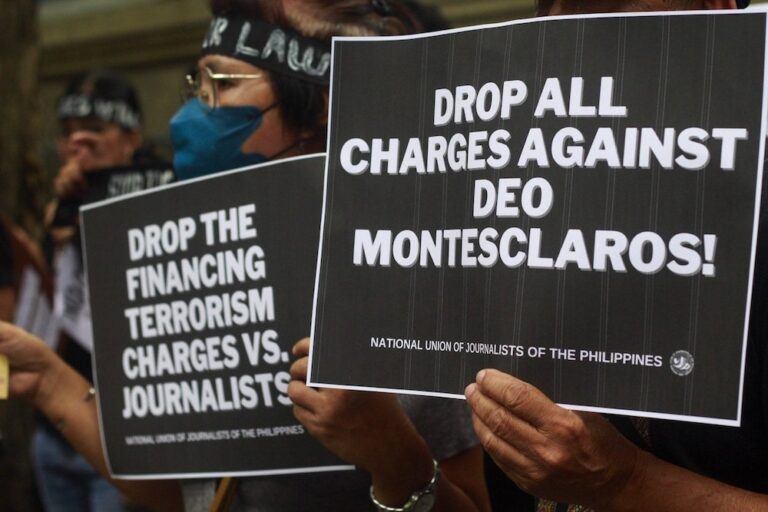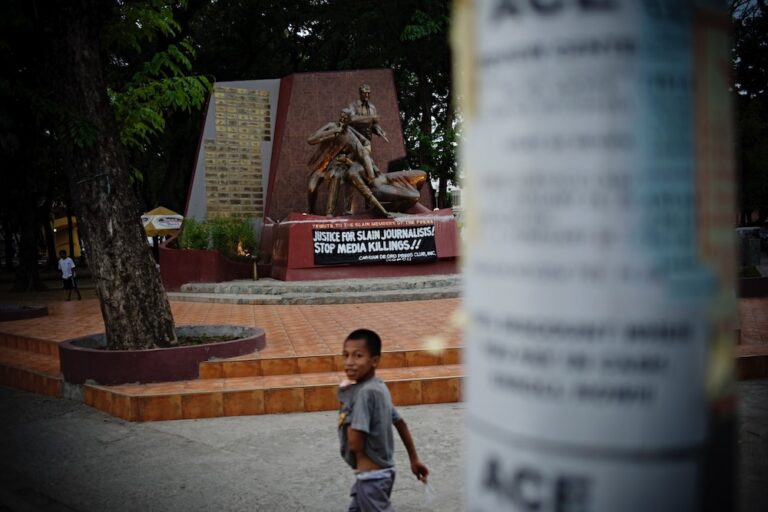(RSF/IFEX) – In a letter to Minister of the Interior José Lina, RSF expressed deep concern over the murder of Candelario “Jun” Cayona, a journalist with radio station DXLL in Zamboanga, on Mindanao Island in the southern Philippines. RSF asked the minister to “intervene to ensure that the security services identify those responsible for master-minding […]
(RSF/IFEX) – In a letter to Minister of the Interior José Lina, RSF expressed deep concern over the murder of Candelario “Jun” Cayona, a journalist with radio station DXLL in Zamboanga, on Mindanao Island in the southern Philippines. RSF asked the minister to “intervene to ensure that the security services identify those responsible for master-minding and carrying out this killing.” RSF also asked to be kept informed of the inquiry’s progress. “The government must show its authority in this part of the country by fighting the impunity that the killers of journalists enjoy. This is all the more important given that this journalist received death threats from a high army official just eight months ago,” noted Robert Ménard, RSF’s secretary-general.
According to information obtained by RSF, Cayona, a broadcaster with radio station DXLL, was murdered on the morning of 30 May 2001 while leaving home on his motorcycle to go to the radio station’s offices in Zamboanga. Two unidentified people fired five bullets, one hitting him in the head. Cayona, 27 years of age, died instantly. The reporter’s family said he had received death threats following some of his programmes. According to his colleagues, the broadcaster had received threats since broadcasting an interview with one of the leaders of the Islamic rebel group Abu Sayyaf. This interview, broadcast during the Jolo hostage crisis, provoked the anger of the authorities, especially the army. Colonel Jovenal Narcise, the commander of the Philippine Army’s forces in Zamboanga, told the journalist on 17 September 2000, “If I hear you interview Sabaya [the Abu Sayyaf spokesperson] again, I will kill you.” Since then, Cayona held interviews several times with leaders of Abu Sayyaf, which has been holding another group of western tourists hostage in the country’s south since 27 May.
Police have opened an investigation into the journalist’s murder, but say they do not yet have any serious leads.
The assassination follows a government announcement on 29 May of a media “black out” of its conflict with the Abu Sayyaf rebels on the country’s south-western islands, including Jolo.
Two other journalists have been killed on Mindanao Island in the last six months. On 24 February, Mohammad Yusop, commentator for RXID radio of the Islamic Radio Broadcasting network, was shot in the head in Pagadian City (see IFEX alert of 28 February 2001). On 17 November 2000, Olimpio Jalapit, broadcaster with the private radio station DXPR, was killed in the same city. Police have still not arrested any of the suspects, one of them a former military officer identified by a witness (see IFEX alert of 20 November 2000).
Cayona is the third journalist killed in Zamboanga since the fall of Ferdinand Marcos’s authoritarian regime in 1986. In 1993, armed men killed a broadcaster at a Christian radio station. In 1998, two unidentified attackers shot Rey Bancairin, a journalist with DXLL, in the station’s broadcast studio (see IFEX alert of 31 March 1998).
For further information, contact Vincent Brossel at RSF, 5, rue Geoffroy Marie, Paris 75009, France, tel: +33 1 44 83 84 84, fax: +33 1 45 23 11 51, e-mail: asie@rsf.fr, Internet: http://www.rsf.fr


